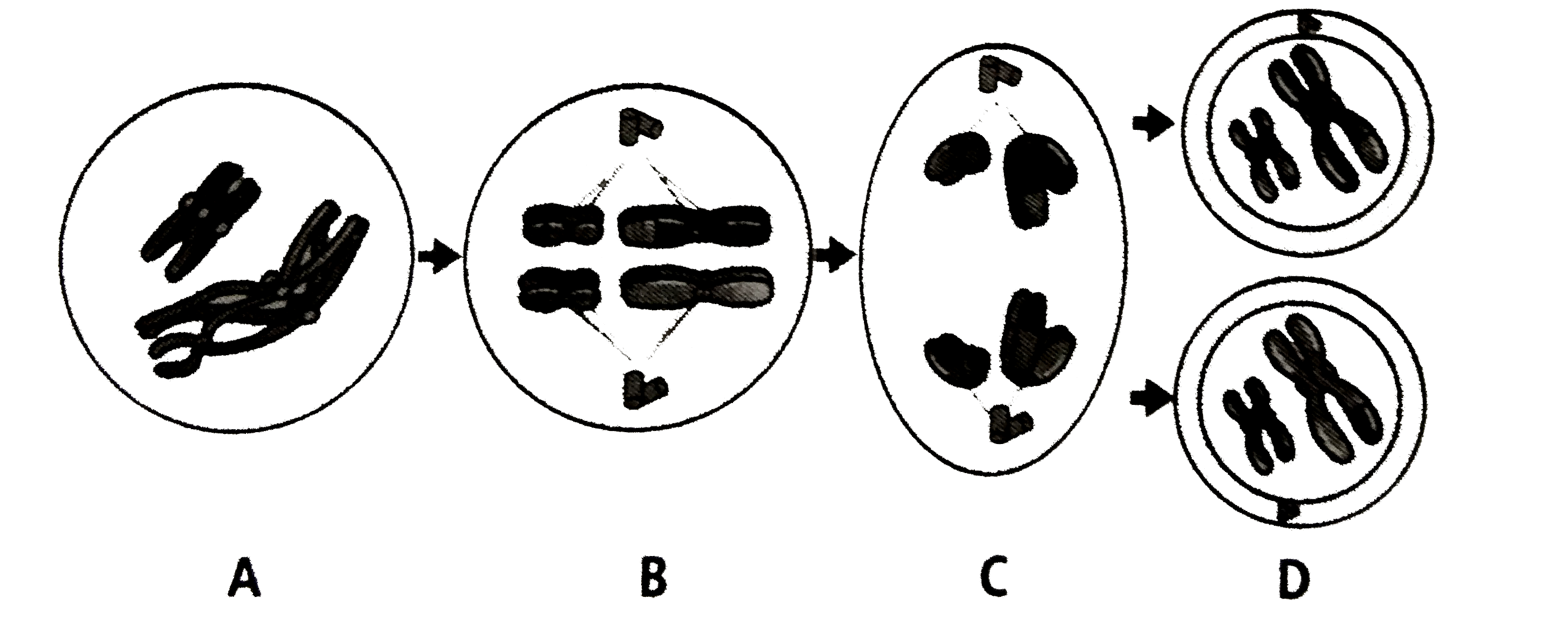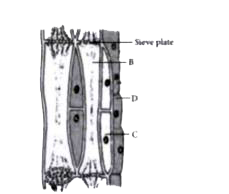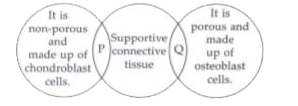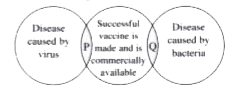Refer to the given d ichotomous key. Identify P -T and select the correct statement regarding them.
I. (a) It is a unicellular organism. - Go to II
(b) It is a multicellular organism. - Go to IV
II. (a) It possesses well organised nucleus. - Go to III
(b) It lacks well organised nucleus. - P
III. (a) Nutrition is parasitic. - Q
(b) Nutrition is mixotrophic. - R
IV. (a) It possesses chlorophyll. - S
(b) It lacks chlorophyll. - T
P could be slipper animalcule.
R could be Euglena which possesses cilia that help in movement.
Q could be Plasmodium which causes malaria or it could be entamoeba which causes amoebic dysentery in humans.
S could be an alga li ke chlamydomonas whereas T could be a scavenger like vulture or a decomposer like Giardia.
The correct Answer is:C
To solve the question using the given dichotomous key, we will identify the organisms P, Q, R, S, and T step by step.
1. Identify P:
- The first question in the dichotomous key asks if the organism is unicellular or multicellular.
- Since P is identified under the option "It lacks well-organized nucleus," we conclude that P is a prokaryotic organism.
- Prokaryotic organisms are typically unicellular. Therefore, P could be a type of bacterium, such as E. coli or Streptococcus.
2. Identify Q:
- Q is reached after determining that the organism possesses a well-organized nucleus and has parasitic nutrition.
- This indicates that Q is a eukaryotic organism that is a parasite.
- A well-known example of this is Plasmodium, which causes malaria.
3. Identify R:
- R is reached after determining that the organism possesses a well-organized nucleus and has mixotrophic nutrition.
- Mixotrophic organisms can perform both autotrophic (photosynthesis) and heterotrophic (feeding on other organisms) nutrition.
- An example of R could be Euglena, which has chlorophyll and can photosynthesize but also feeds on organic material.
4. Identify S:
- S is reached after determining that the organism is multicellular and possesses chlorophyll.
- This indicates that S is likely a plant or an alga.
- A common example of S could be Chlamydomonas, which is a unicellular green alga but can also represent multicellular algae.
5. Identify T:
- T is reached after determining that the organism is multicellular and lacks chlorophyll.
- This indicates that T could be a fungus or an animal.
- An example of T could be a vulture, which is a scavenger bird that does not have chlorophyll.
Summary of Identifications:
- P: Prokaryotic organism (e.g., E. coli)
- Q: Plasmodium (causes malaria)
- R: Euglena (mixotrophic)
- S: Chlamydomonas (alga)
- T: Vulture (multicellular, lacks chlorophyll)
Correct Statement:
The correct statement regarding these organisms is that Q (Plasmodium) is a parasite causing disease, while P (E. coli) is a prokaryotic organism.
- The first question in the dichotomous key asks if the organism is unicellular or multicellular.
- Since P is identified under the option "It lacks well-organized nucleus," we conclude that P is a prokaryotic organism.
- Prokaryotic organisms are typically unicellular. Therefore, P could be a type of bacterium, such as E. coli or Streptococcus.
- Q is reached after determining that the organism possesses a well-organized nucleus and has parasitic nutrition.
- This indicates that Q is a eukaryotic organism that is a parasite.
- A well-known example of this is Plasmodium, which causes malaria.
- R is reached after determining that the organism possesses a well-organized nucleus and has mixotrophic nutrition.
- Mixotrophic organisms can perform both autotrophic (photosynthesis) and heterotrophic (feeding on other organisms) nutrition.
- An example of R could be Euglena, which has chlorophyll and can photosynthesize but also feeds on organic material.
- S is reached after determining that the organism is multicellular and possesses chlorophyll.
- This indicates that S is likely a plant or an alga.
- A common example of S could be Chlamydomonas, which is a unicellular green alga but can also represent multicellular algae.
- T is reached after determining that the organism is multicellular and lacks chlorophyll.
- This indicates that T could be a fungus or an animal.
- An example of T could be a vulture, which is a scavenger bird that does not have chlorophyll.
- P: Prokaryotic organism (e.g., E. coli)
- Q: Plasmodium (causes malaria)
- R: Euglena (mixotrophic)
- S: Chlamydomonas (alga)
- T: Vulture (multicellular, lacks chlorophyll)
The correct statement regarding these organisms is that Q (Plasmodium) is a parasite causing disease, while P (E. coli) is a prokaryotic organism.
Topper's Solved these Questions
Similar Questions
Knowledge Check
- Question 1 - Select One
Refer to the given dichotomous key. Identi fy P -T and select the incorrect statement.
I. (a) It is unicellular organism. - Go to II
(b) It is multicellular organism. Go to IV
II. (a) It possesses well organised nucleus. Go to III
(b) It lacks well organised nucleus. -P
III. (a) Nutrition is parasitic. -Q
(b) Nutrition is mixotrophic. -R
IV. (a) It possesses chlorophyll. - S
(b) It lacks chlorophyll. -TAP can convert lactose sugar of milk into lactic acid.BR could be Euglena which possesses cilia that helps in movement.CQ could be Plasmodium which causes malaria or it could be Entamoeba which causes amoebic dysentery in humans.DS could be a plant like pondweed whereas T could be a scavenger like vulture or a decomposer like Rhizopus. - Question 2 - Select One
Refer to the given dichotomous key. Identi fy P -T and select the incorrect statement.
I. (a) It is unicellular organism. - Go to II
(b) It is multicellular organism. Go to IV
II. (a) It possesses well organised nucleus. Go to III
(b) It lacks well organised nucleus. -P
III. (a) Nutrition is parasitic. -Q
(b) Nutrition is mixotrophic. -R
IV. (a) It possesses chlorophyll. - S
(b) It lacks chlorophyll. -TAP can convert lactose sugar of milk into lactic acid.BR could be Euglenaa which possesses cilia that helps in movement.CQ could be Plasmodium which causes malaria or it could be Entamoeba which causes amoebic dysentery in humans.DS could be a plant like pondweed whereas T could be a scavenger like vulture or a decomposer like Rhizopus. - Question 3 - Select One
Refer to the given stages A,B,C and D of meiosis I and select the incorrect statement regarding them.
 AThe last stage of A is diakinesis which is marked by terminalisation of chiasmata.BIn stage B, mictrotublues from the opposite poles of the spindle attach to the pair of homologous chromosomes.CIn stage C, homologous chromosomes separate. While sister chromatids remain associated at their centromeres.DIn stage D, nuclear membrane and nucleolus disappear, cytokinesis follows and this is called as dyad of cells.
AThe last stage of A is diakinesis which is marked by terminalisation of chiasmata.BIn stage B, mictrotublues from the opposite poles of the spindle attach to the pair of homologous chromosomes.CIn stage C, homologous chromosomes separate. While sister chromatids remain associated at their centromeres.DIn stage D, nuclear membrane and nucleolus disappear, cytokinesis follows and this is called as dyad of cells.
Refer to the given figure and select the correct statement regarding B, C, D.
 View Solution
View SolutionRefer to the given Venn diagram and select correct statement regarding P and Q.
 View Solution
View SolutionRefer to the given Venn diagram and select the correct option regarding P and Q.
 View Solution
View SolutionRefer to the given dichotomous key and select the correct option regarding P, Q, R, S and T.
I. (a) Genetic material is not enclosed in nucleus. - Go to II
(b) Genetic material is enclosed in nucleus. - Go to III
II. (a) Lacks cell wall. - P
(b) Possesses cell wall. - Q
III. (a) Unicellular organism - R
(b) Multicellular organism - Go to IV
IV. (a) Plant body is sporophytic and water is required for fertilisation. - S
(b) Plant body is sporophytic and water is not required for fertilisation. - TView SolutionRefer to the given dichotomous key and select the incorrect option regarding organisms P, Q, R and S.
I. (a) Animals with cellular level of body organisation. - __P__
(b) Animals with tissue/organ/ organ system level of body organisation. - Go to II
II. (a)Animals possessing bilateral symmetry. - Go to III (a)
(b)Animals possessing radial symmetry.- Go to III (b)
III. (a) True coelom is present. - Go to IV (a)
True coelom is absent. - Go to IV (b)
IV. (a) Notochord is present. __Q__
(b) Notochord is absent. - Go to V
V. (a) It is represented by medusa form. ____R___
(b) It is represented by polyp form. - ___S___View Solution
